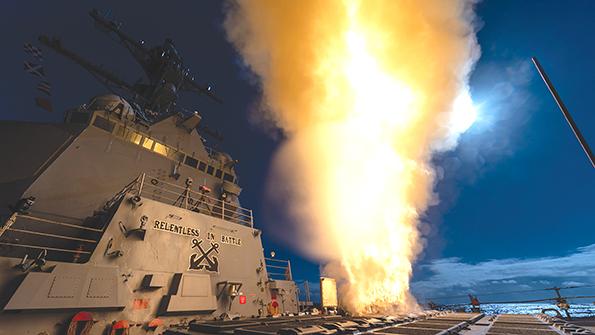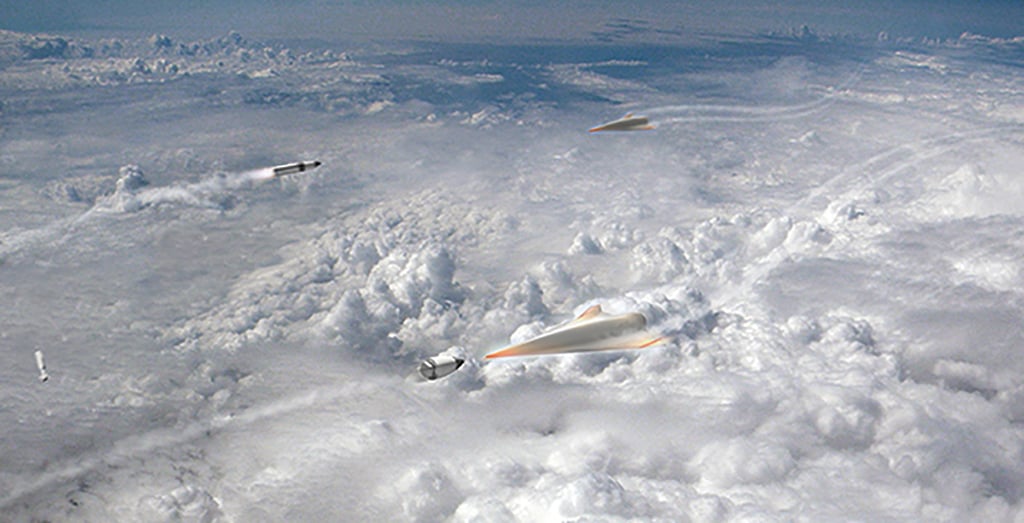This article is published in Aviation Week & Space Technology and is free to read until May 24, 2024. If you want to read more articles from this publication, please click the link to subscribe.

A Glide Phase Interceptor would complement existing sea-based missile defenses, such as this SM-3 Block IIA interceptor fired by the USS McCampbell during a Feb. 8 test.
The U.S. will take even longer to field a purpose-built, long-range hypersonic defense system expected by the 2030s, despite a $1 billion cash injection from Japan, but Pentagon officials say they can speed up a less capable alternative by the end of the decade.
The threat posed by offensive hypersonic glide vehicles (HGV) materialized less than five years ago. Russia’s Avangard and China’s DF-17 and -27 missile systems are now operational, with the latter posing a long-range threat to U.S. warships and land bases in the Western Pacific region.
- Japan is expected to contribute $1 billion for the Glide Phase Interceptor
- Lawmakers push back against Interceptor delay
In response, the U.S. Missile Defense Agency (MDA) so far has fielded the SM-6 Sea-Based Terminal system. A software update endows the short-range interceptor with a limited capability to shoot down an HGV in the final and most challenging terminal phase of flight, MDA officials say. But the proof—an interception test against a threat-representative HGV target—is not scheduled until fiscal 2026.
Terminal-phase defense is not enough. To improve chances of a shootdown, MDA officials say a surface-to-air missile interceptor needs the speed, range and maneuvering flexibility to target HGVs during the glide phase. If the interceptor misses, it would still force the HGV into evasive maneuvers, slowing it down and improving the chances of a later shootdown.
However, the MDA has struggled to define a feasible long-range defense system that can be fielded before the congressionally mandated deadline in 2029. The agency scrapped the Regional Glide Phase Weapon System (RGPWS) in 2021 as too complex. Instead, it launched the scaled-down Glide Phase Interceptor (GPI) program, hoping initially to conduct a successful demonstration in the early 2030s and now targeting the end of the decade.
Northrop Grumman and RTX have been competing since last year for the contract to develop the ship-based GPI as the MDA’s promised long-range defense system. However, the fiscal 2025 budget request revealed a shakeup within the program. Instead of a years-long competition, the agency plans to select its prime contractor by the end of fiscal 2024.
Meanwhile, despite accelerating the selection decision, the MDA has delayed the GPI’s initial operational capability milestone by another year to 2035. Warships and land bases in the Western Pacific must wait 11 years to receive the promised long-range hypersonic defense system.
U.S. lawmakers pushed back against the delay during an April 12 hearing of the House Armed Services Strategic Forces Subcommittee.
“I’m concerned that these decisions simply accept too much risk and that missile defense appears to have become a bill-payer for other capabilities in this budget,” said Subcommittee Chairman Rep. Doug Lamborn (R-Colo.). “This is difficult to understand, given the growth in missile threats.”
The fiscal 2025 budget request also reveals a 33% overall cut in spending plans for GPI over the next five years, lowering the Pentagon’s share of costs to $1.16 billion through fiscal 2029.

New funding from Japan may offset U.S. cuts. Prime Minister Fumio Kishida met with President Joe Biden at the White House on April 10 as their staffs continued to negotiate Japan’s role in the GPI program.
The Pentagon now expects Tokyo to invest $1 billion in the counterhypersonic capability, John Hill, deputy assistant secretary of defense for space and missile defense, stated in written testimony submitted to the subcommittee on April 12. Japanese industry will contribute to the GPI supply chain, leveraging the country’s position as a booster supplier for the Raytheon SM-3 Block IIA ballistic missile interceptor.
In the meantime, the MDA is working on an interim capability for long-range hypersonic defense that could be fielded by the end of the decade. It is considering options for modifying existing interceptors for glide phase interceptions, perhaps similar to how the SM-6 was adapted for a short-range counterhypersonic role. Some elements of the GPI program could be ready to support the interim capability by 2029.
“We’ve engaged with both of our primes on the GPI program today to identify opportunities that they see within their industry space and their broader enterprises to come up with acceleration options that we could be taking within the GPI program,” MDA Director and Air Force Lt. Gen. Heath Collins said during the hearing. “I’m also looking across at other weapon systems that we have in place today to understand what, if any, residual capability they may have . . . or smaller developments we [could] take within those other weapons systems that could bring some type of residual capability or interim capability to the fight.”
The MDA studied several options for long-range hypersonic defenses in 2018-19, awarding nearly two dozen contracts for Hypersonic Defense Weapon System studies to multiple companies. Among the five finalists for what became the short-lived RGPWS, the agency considered several adaptations of existing interceptors, including Raytheon’s proposed new SM-3 variant. Lockheed Martin proposed an extended-range variant of the Terminal High-Altitude Area Defense system and the Patriot interceptor. Additional technologies reviewed included hypervelocity projectiles and a ground-based, high-power microwave system.
Other concepts are being developed outside the MDA. DARPA awarded Boeing a $70 million contract in September to launch Phase 2 of the secretive Glide Breaker program. Details of Phase 2 have not been released, but the focus of the initial phase included development of an advanced divert and attitude control system for a long-range hypersonic interceptor.
“Let’s open up our aperture and consider all services, all ideas, and figure out a way to harness that which can be delivered in the time of relevance,” Paul Mann, MDA program executive for sea-based weapon systems, said on an April 8 panel during the Sea-Air-Space exposition. He added that the agency still lacks funding to adopt a wider approach to defending assets, such as warships, from missile-launched HGVs. “I don’t know how this is going to play out,” he said.
Fifteen years ago, Mann served as the Marine Corps joint program manager for the Mine-Resistant Ambush Protected (MRAP) vehicle program, which delivered 12,000 MRAP vehicles at the height of insurgent attacks on U.S. forces in Iraq and Afghanistan in 2007-12. His favored acquisition approach prioritizes buying obtainable technologies rather than inventing new capabilities, if possible. He contrasted that with the typical Pentagon process that establishes requirements first and then considers how they can be acquired.
“Instead of requiring and then acquiring, it’s ‘What can you acquire?’” Mann explained. “And let’s study it. Let’s experiment. Let’s see if there’s relevance to it. And then we’ll write the requirement, or we’ll adapt. Because if you keep writing something that’s ‘unobtainium,’ it just confounds everybody, and you can’t afford it. It doesn’t arrive on time. That said, maybe that requirement is still valid.”
Mann cited the Pentagon’s Strategic Capabilities Office as a paragon of his preferred acquisition philosophy. “They don’t invent anything, but they adapt it, and they use stuff that already is on planet Earth, and they figure out a way to give it a little bit of military value,” he said.
Even so, the long-range hypersonic threat presents a considerable technological challenge. The MDA’s spending plans for the hypersonic defense system still pale in comparison to interceptor programs focused primarily on ballistic threats. However, the technical challenged posed by maneuverable hypersonic missiles is higher, Mann said.
“This is really, really, super hard,” he noted. “And we thought ballistic missile targets were hard. We thought low-elevation targets were hard—and anti-air warfare. This maneuvering hypersonic thing is confounding and defying the laws of physics in so many ways. There’s so much work to do, but it’s not one team that’s going to do what is gonna be really an all-of-nation project. And I think there are pockets of it popping up all over. We just need to figure out how to bring it, harness it.”





